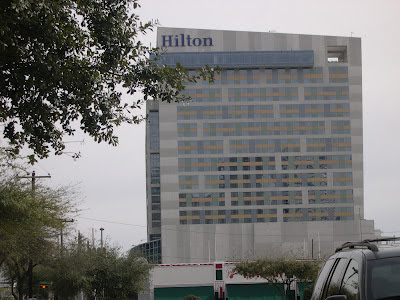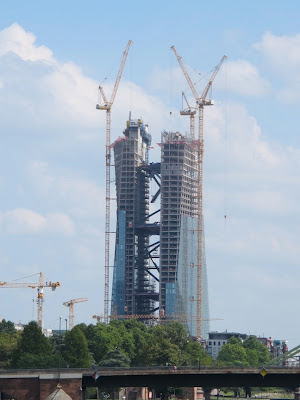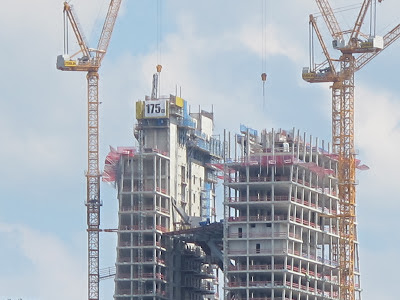FRANKFURT AM MAIN.
Although somewhat renown in the recent past as the most substantial skyline of continental Europe, this hyperbolic moniker's impact has diminished as European skyscrapers became less unusual, and especially as European skyscrapers have become more common, such as post-1990s Rotterdam or Warsaw, much less when considered against the hundreds of formally-flat cityscapes from Doha to Shenzhen which today appear as a shimmering walls of highrises.
Top: southeastern Frankfurt: The Romer, the Main Plaza, the ECB Tower
Bottom: Central-East Frankfurt, the Zeil Hochhaus and Jumeirah Hotel at Left, the ECB at far right.
©2012 Bauzeitgeist.
Not that anyone besides journalists and architectural enthusiasts have ever used the term "Mainhattan," But to at any point call Frankfurt's small cluster of not-particularly-tall buildings a peer to New York's miles-wide skyline was always ridiculously overblown. A more appropriate, if less cosmopolitan, reference would be to a similarly-sized and shaped American city. Frankfurt's skyline was never more substantial or impressive than the elevation of downtown Pittsburgh or Nashville.
Left: Messeturm, Frankfurt, by Helmut Jahn, 1990.
Right: NationsBank, Atlanta, by Roche Dinkeloo, 1992.
Both images via Wikipedia Commons.
What had begun as a few German-designed glass boxes pre-1989 was joined by colorful, whimsical bank buildings rising up around the Bahnhofvertiel, of the same generation as the neoclassical office towers that became the tallest buildings in many American cities from Cleveland to Charlotte in the 1990s, as both continents reached the apex of transatlantic corporatism.
Left: Westend Tower, by Kohn Penderson Fox, 1993. Photo ©2003 Bauzeitgeist.
Right: US Bancorp, Minneapolis, by Pei Cobb 1992. Image via Wikipedia.
This resulted in such towers as the pyramid-capped Messeturm, which would not look out of place in Atlanta's midtown; KPF's Westend Tower, whose curving-white brise-soliel was, its hard to comprehend now, seen as daring when it was completed, spawned identical hundreds across the North America from Miami to Vancouver, later spreading to other continents. Yet Westend Tower completed a year after Pei Cobb's US Bancorp in Minneapolis opened in 1992, crowned with a similar fan.
Lastly, and while not copying so closely an particular tropes of American post-modernism, the strangely-crowned Trianon Tower has no closer kin than the Centerpoint Energy Plaza in Houston.


Top: Centerpoint Energy Plaza, Houston, with its 1996 crown. ©2003 Bauzeitgeist
Bottom: Trianon, Frankfurt, built 1999. ©2003-2012 Bauzeitgeist
Top: Main Plaza, Frankfurt, 2001. Photo @2012 Bauzeitgeist.
Bottom: American Radiator Building, 33rd Street, New York, by Raymond Hood, 1924.
Image via Wikipedia Commons.
On a recent visit to Frankfurt, specifically to view the exhibit at the DAM, two prominent additions to Frankfurt skyline show that Frankfurt's skyscraping continues on, but perhaps with new influences and inspirations. In the center of the city, just off the Zeil, the city's wide fußgangerzone, rises the stylish Jumeirah Hotel, the newest outpost of the Dubai-based luxury hotel chain.
Jumeirah Frankfurt and the Zeil Hochhaus. ©2012 Bauzeitgeist.
This new developed is adjacent to the historic Thurn und Taxis Palais, but the hotel does not utilize the older building for a substantial street presence or spacious lobby. Instead, a narrow corridor with lectern-sized front desks opens directly onto the ground floor of one the bustling, glittery, mid-market malls which dominate the pedestrian shopping precinct. While linking luxury towers to malls is a standard real estate cocktail around the world, its a formula which is waning in North America at the same time it is worshipped in Arabia, and it seems telling that luxury was conveyed in this particularly non-European fashion.
Hilton Hotel Houston ©2003 Bauzeitgeist.
The Jumeirah, part of the Zeil Hochhaus I & II phase of the Palais Quartiel development, might therefore be best described as a Gulf hotel in a German city, programmatically, stylistically, and architecturally following the bland luxury development formula that is applied in cities everywhere nowadays.
What is therefore more remarkable both in scale and its peripheral location is the substantial European Center Bank Headquarters at the southeastern limit of the city center, at the Großmarkthalle, a vegetable market which also played an ignominious role in assembling deportees from the city during the Holocaust.
This huge complex rises outside the normally skyscraper-belt, and it is interesting to speculate on the meaning and impact of the ECB's new location, whether this move from the Bahnhofverteil to the Großmarkt marks Frankfurt's shift from its City to its Canary Wharf, especially when viewing central Frankfurt's distant cluster of skyscrapers from the riverfront, docklands-like construction site around the Großmarkthalle. German cities never shielded their centers from development like Paris, but its most skyscraper-strewn city may yet get its La Defense.
Frankfurt's Docklands: The Großmarkthalle site at a bend in the river,
southeast of the city's center, with the existing financial district several miles distant.
The Main Plaza is at mid-center left, behind the bridge.
See Google Earth image at top of post to note how the oxbow bend of the Main echoes the Thames at the Docklands.
Above Image via Wikipedia.
The huge ECB premises, with twin towers pivoting toward each other at an angle connected by multiple, cantilevering sky-bridges between, is dashingly contemporary in its styling. This is the latest iteration of an emerging kinship of such twin-towers, most especially such supersleek developments as the World Trade Centre in Bahrain, which has been mentioned in this blog a few times before.
Bahrain's World Trade Center, c.2008. Image via Inhabitat.
A fable for our times, the ECB has been working on a substantial new building throughout a crisis which now impugns the very concept of a centralized Europe, which has lead no less than George Soros that Germany should either save or leave the Euro.
While last week's announcement that the ECB development would be overbudget by 41% was met with exasperated derision and humor, that the ECB seems to be emulating new financial capitals much farther to the southeast from its old offices, the sovereign-wealth-fund federation between Doha and Abu Dhabi, with a glittering, Gulf-like financial center. Rather than recall a more rational and socially beneficial heritage of finance, the ECB's architecture reflects out to the flashy new centers of money.
Despite its under-rated museums and its pleasant quality of life, Frankfurt is only a cross-roads of trade and transport, without the overlay of romance and art that defines London or New York. Its central district holds the late-evening routes of lonely foreign businessmen, not the storied streets of a world capital. Frankfurt may so badly wish to be compared to these sophisticated cities, but it continues to grow by building upward with skyscrapers evoke those duller, more commonplace business districts that are its true peers.
























No comments:
Post a Comment
Note: Only a member of this blog may post a comment.